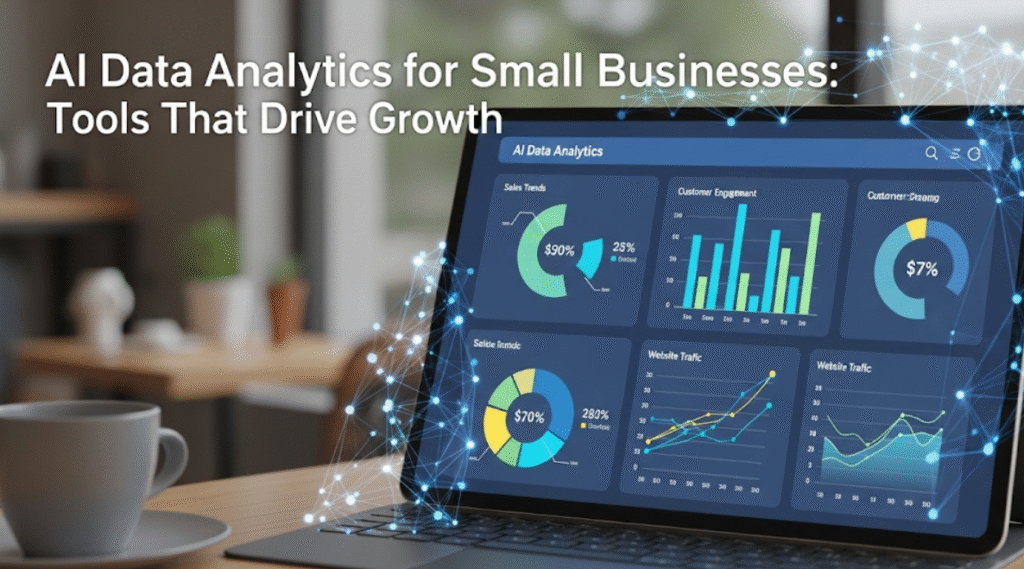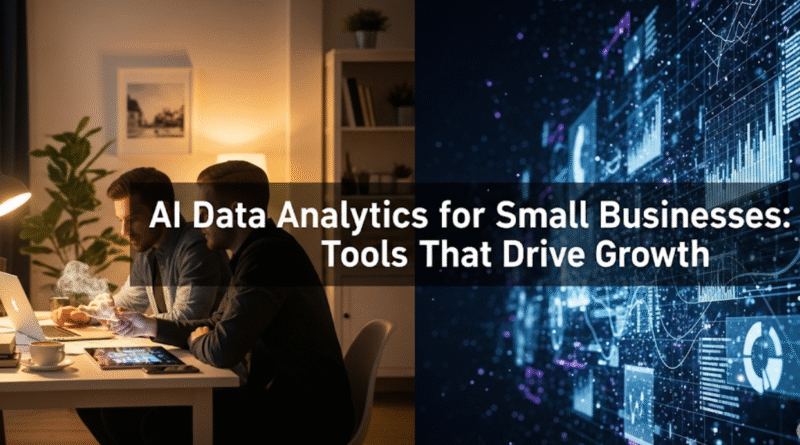AI Data Analytics for Small Businesses: Tools That Drive Growth
Small business owners are multi-tasking experts. Managing inventory, demanding email customer service—the problem is you’re sitting on top of a treasure trove of information just waiting to be mined from your day-to-day activity. Yes, I am talking about the goldmine—your data—and with tools that unleash AI analytics to dig it out profitably.
Gone are the days when data analytics was solely a playground for big corporations with deep pockets for IT departments. Now, AI tools help small companies use analytics effectively with the powerful insights of advanced statistical models but without the complexity and expense that made these previously unattainable.
This post will explore exactly how AI data analytics can help drive growth in your small business, which tools are most effective for the job, and tips to get you started affordably without having to go back to school for a degree in computer science.
Read More: Entrepreneur(Arrays) — Small Business and AI Data Analytics in 2021
Business changes quickly and expectations of customers change even more rapidly. Gut-feeling and traditional method-based small businesses are sinking and losing to their counterparts that take informed actions.
The New Problem Facing Small Business Owners
We are Checklist Design, and we help owners of small businesses to make sense of all that data that they collect every day. There are purchases in your point-of-sale system, behavior results from your website analytics, engagement metrics from social media platforms, and customer reviews in all of the places. However, without the proper tools to scramble this data, it is just left in useless wilderness.
Most traditional analytics tools were built for big businesses and require a squad of data nerds to maintain. They’re too expensive, too complex, and require technical knowledge that very few small business owners have the time to develop.
How AI Changes the Game
AI analytics tools help solve this issue by taking the reins. They automatically:
- Discover patterns in your sales data
- Predict customer behavior
- Discover marketing campaigns that actually work
- Look to save and make money wherever you can
- Warn you of potential issues that could harm your business
The best part? The modern AI tools are designed for non-technical individuals. You have no need for understanding complex formulas or making intricate reports. In other words, the AI does the data analyzing and then reflects the results in plain English.
These are the key benefits which ultimately drive real business growth.
Smarter Customer Targeting
This means that AI analytics can help you to identify your best customers and target more people like them. You can also turn away from the traditional approach of throwing a marketing budget wide and in desperation hoping that somebody—anybody!—will give you money for your product, and focus on only those who are absolutely willing to buy your stuff.
As an example, a neighborhood bakery can use AI analytics to uncover that people who purchase coffee on Tuesday mornings are three times more likely to have custom cakes made for their events. With that info, they can create ads for Tuesday morning promotions on cake decorating.
Inventory Optimization That Saves Money
Frustrating customers with popular items that have run out of stock is costly in both wasted sales and customer dissatisfaction. Overstocking is risky because it blocks cash and leads to waste. AI analytics has attached a crystal ball to the front of your store by forecasting demand using:
- Historical sales patterns
- Seasonal trends
- Local events and holidays
- Weather patterns
- Economic indicators
A hardware store could find out that paint sales go through the roof 2 weeks before long holiday weekends, and you know to order up just in time, instead of having too much inventory on hand all year long.
Pricing Strategies That Maximize Profit
These AI tools analyze information on your costs, the prices of competitors, changes in customer behavior, and market conditions to determine what prices should be set for different products/services. This dynamic pricing tactic can dramatically increase your profit margins.
Long Term Value Generation: Retaining Customer Ease
The cost to get a new customer is 2.5 times the cost of keeping an existing one. AI analytics spots customers who are most likely to churn, utilizing purchase trends, complaint records, and how engaged they are. This way, you can do something to keep those relationships from dying a slow death.
Best AI Data Analytics Tools For Small Businesses
Google Analytics 4 – AI-Driven Insights
Price: Free
Ideal for: Website & Online Business Analytics
Google Analytics 4 comes with a robust set of AI features that automatically reveal valuable insights about your website traffic and online sales. The tool reveals existing trends, tells you what is likely to happen in the future, and what each person should do to increase productivity.
Key Features:
- Predictive analytics for customer behavior
- Automated anomaly detection
- Cross-channel tracking (Website, App, Social Media)
- Conversion optimization recommendations
Zoho Analytics
Price: From $22/user/month
Ideal for: Full-featured business intelligence
Many different streams (sales, marketing, finance, inventory) are synchronized in user-friendly dashboard reports when using Zoho Analytics. With Zia, the AI assistant automatically provides insights and answers any questions that you may have on your data in natural form.
Key Features:
- Drag-and-drop report builder
- Automated insights generation
- Integration with 500+ business applications
- Mobile dashboard access
Microsoft Power BI
Price: From $10/month per user
A great fit for: Visual data analysis and reporting
Power BI offers AI capabilities such as natural language queries, automated pattern detection, and predictive forecasting. You could ask questions such as “What were my highest selling products last quarter?” and get instant visual answers.
Key Features:
- AI-powered data preparation
- Natural language question answering
- Real-time dashboard updates
- Strong integration with Microsoft Office
Tableau Public (free) / Tableau Online (Cloud)
Cost: Free limited-service, $70/month and up
Best for: Comprehensive data visualization
The AI functionality of Tableau allows you to identify hidden shapes in your data and is graphically powerful—only good pictures can make complex information easy to understand and share.
Key Features:
- Natural language queries with Ask Data
- Explain Data for automated insight generation
- Smart recommendations for chart types
- Advanced statistical analysis
QuickBooks Analytics
Price: Tied to QuickBooks Online subscriptions
Best Used For: Financial and Accounting Analytics
The built-in analytics features, which use AI and are compatible for those already using QuickBooks for accounting, offer cash flow forecasting, expense categorization, and profit margin analysis.
Key Features:
- Cash flow predictions
- Automated expense tracking and categorization
- Profit and loss trend analysis
- Industry benchmarking
Choosing the Right AI Analytics Tool
Assess Your Current Data Sources
When looking at a tool, start with where you keep your business data and create a list of all the places:
- Point-of-sale systems
- Accounting software
- Email marketing platforms
- Social media accounts
- Website analytics
- Customer service platforms
- Inventory management systems
Choose the ones that have better integration capabilities and make sure they can be plugged easily without manual data entry.
Consider Your Technical Comfort Level
State your technical abilities and the time at hand. Certain tools require more setup and maintenance.
- Beginners: Google Analytics 4 or QuickBooks Analytics (if you use QuickBooks)
- Intermediate users: Zoho Analytics or Microsoft Power BI
- Advanced users: Tableau has the most robust features, but takes more time to learn
Budget Considerations
| Tool | Price Monthly | Time to Setup | Difficulty |
|---|---|---|---|
| Google Analytics 4 | Free | 2-4 hours | Easy |
| QuickBooks Analytics | Included with QB | 1 hour | Very Easy |
| Zoho Analytics | $22+ | 4-8 hours | Moderate |
| Microsoft Power BI | $10+ Per User | 6-12 hours | Moderate |
| Tableau | $70+ per user | 12+ hours | Advanced |
Start Small and Scale Up
Do not attempt to analyze everything simultaneously. Choose just one part of the business—sales or marketing—and develop a way to get some value from AI analytics there first. More areas can be added when you have success.
Your First 30 Days with AI Analytics
Week 1: Data Gathering and Infrastructure
Game plan:
- Days 1–3: Audit your current data sources and identify the biggest business questions that need to be answered
- Days 4–5: Research and choose your first AI analytics tool
- Days 6–7: Install the toolkit and connect main data sources
Week 2: Basic Setup and Exploration
Game plan:
- Days 8-10: Create your first dashboards around sales, traffic, or customer acquisition
- Days 11-12: Learn about the AI-powered insights and recommendations
- Days 13-14: Set up automatic reports via email and mobile notifications
Week 3: Pattern Recognition and Analysis
- Days 15–18: Use AI features to discover insights in your data
- Days 19–20: Check how you are performing today and compare current performance with historical insights
- Day 21: Document top 3 insights from analysis
Week 4: Action and Implementation
- Days 22-25: Develop a set of action plans based on your insights
- Days 26-28: Execute those changes in the operations of your business
- Days 29-30: Establish tracking to measure the impact of the changes that you made

Avoid These Common Pitfalls When Implementing AI Analytics
Tracking Everything At The Same Time
This is a classic situation: new users create all the dashboards for every metric they are tracking. This results in the ever-so-common “information overload” and/or analysis paralysis. Limit the number of key performance indicators (KPIs) to 3–5 that are measurable towards your goals.
Ignoring Data Quality
AI analytics tools can only be as good as the data they consume. Ensure your data is:
- Accurate and up-to-date
- Consistently formatted
- Complete (no major gaps)
- Relevant to your business decisions
Not Acting on Insights
Without some change in the business as a result of our research, the world’s prettiest dashboard is no use. Schedule regular analytics reviews weekly or monthly to evaluate and act on insights.
Expecting Instant Results
While AI analytics can certainly derive valuable insights, it takes time to see the full implications on your company. Be patient and let your changes work before changing anything else.
Small Business Success Stories with AI Analytics
23% Increase in Revenue for a Small Restaurant Chain
A modern restaurant group with 3 branches used AI analytics to adjust pricing and control inventory. They analyzed sales patterns and weather data in combination with local events, reduced food waste by 30%, and were able to up-sell items based on the menu that was most likely to increase average order value.
E-commerce Store Doubles Customer Retention
An online store that sells handmade crafts detected churn using AI analytics. In addition to offering targeted promotions and optimizing email frequency, they sent re-engagement emails based on purchasing patterns and browsing behavior. With this strategy, they saw a 45% increase in repeat purchases while reducing acquisition costs for new customers.
35% Cash Flow Increase for Service Business
A plumbing company leveraged AI-driven financial analytics to implement value-based pricing strategy and improve accuracy of financial forecasting. Additionally, they enhanced cash flow by recognizing late payment trends and preemptively communicating with at-risk accounts.
Future of AI Analytics for Small Businesses
Artificial intelligence analytics software becomes more accessible and affordable for everyone each year. Here’s what to expect:
Increased Automation
Future tools will require even less involvement and intervention. They will automatically uncover insights and propose actionable recommendations that you can implement to grow your business.
Better Integration
The next logical step will be platforms that integrate seamlessly with more business tools to draw a full picture of your operations without any manual inputs or integrations.
More Accessible Pricing
As competition increases and technology improves, we will see AI analytics tools become cheaper with more free and low-cost options available for small businesses.
Voice and Conversational Interfaces
In the near future, you will be able to use voice interfaces or type in natural language to ask your analytics tool questions just as if they were another human.
Measuring Your AI Analytics Success
To get a return on your AI analytics investment, track these metrics:
Business Impact Metrics
- Revenue growth rate
- Profit margin improvements
- Customer acquisition cost reduction
- Customer lifetime value increase
- Inventory turnover improvements
Operational Efficiency Metrics
- Time saved on reporting and analysis
- Faster decision-making cycles
- Reduced manual data entry
- Improved accuracy of forecasts
- Better resource allocation
Measure your progress monthly and benchmark before you implement AI analytics. Small companies are seeing improvements in 60-90 days when used properly!
Frequently Asked Questions (FAQs)
What is AI Data Analytics for Small Businesses?
In the context of small businesses, AI data analytics includes tools with automated analysis designed to facilitate informed decision making, providing intelligence and recommendations using business data. These tools enable small business owners to make data-driven decisions without needing technical knowledge or a hefty budget.
What is the cost of AI analytics software for small to medium-sized businesses?
Pricing ranges from free (Google Analytics 4) to $100+ per month for advanced platforms. Most small businesses can get started for less than $50 per month, and many options are available at $10-30, making them accessible and efficient.
How Technical Do I Need To Be When Using AI Analytics Tools?
Modern AI analytics tools are designed for non-technical people. Almost all come with drag-and-drop interfaces, natural language queries, and automated insights that do not require programming or statistical experience. Basic computer skills and a willingness to learn are sufficient.
How fast can AI analytics start providing results?
Most small businesses begin seeing insights within the first week. Measurable business improvements generally become apparent within 60-90 days once you have made changes based on the analytics insights.
How does AI analytics help with inventory management?
AI analytics excels at inventory optimization. They can forecast demand patterns, identify slow-moving stock, optimize reorder levels, and prevent stockouts or overstock situations by processing historical sales data, seasonality, and external factors.
What Sort of Data Does A Small Business Need for AI Analytics?
This could be as simple as sales transactions, website traffic, customer files, and inventory levels, or as comprehensive as marketing campaign results, social media analytics, and financial records. Most small businesses already have sufficient data to benefit from AI analytics.
Will my business data be safe with AI analytics tools?
Reputable tools provide high levels of security such as data encryption, secure cloud storage, and compliance with privacy laws including GDPR. Make sure to review the security and privacy policies of any tool you are considering.
Which AI analytics tool should I choose for my business?
Consider your budget, technical capabilities, key data sources, and use cases. Start with newer, affordable tools such as Google Analytics 4 or QuickBooks Analytics, and progress to more advanced platforms as your needs expand.
Taking Action: Your Next Steps
Becoming proficient with AI analytics tools is a significant competitive advantage for small businesses now and in the future. The trick is to take small steps, answer your top business questions, and build your analytics abilities incrementally.
Remember, the purpose isn’t to become a data scientist—it is to make better business decisions that drive growth and profitability. Any small business owner who takes the first step to implement modern AI analytics tools can achieve this.
Start today, carve out a couple of hours to get started, and use this guide as your blueprint for becoming data-driven in your business growth. Your future self (and your wallet) will appreciate the investment in AI today.
What is clear is that the enterprises that will succeed in the years ahead are those that can rapidly adapt based on new conditions and customer demands. AI analytics provide you with the knowledge to stay competitive and enable fact-driven decisions.
Begin today, start small—but whatever you do, begin! Your competitors are already using these tools, and the longer you wait, the worse position you put yourself in. The data to transform your business is already out there. You now have the keys to unlock its power.

